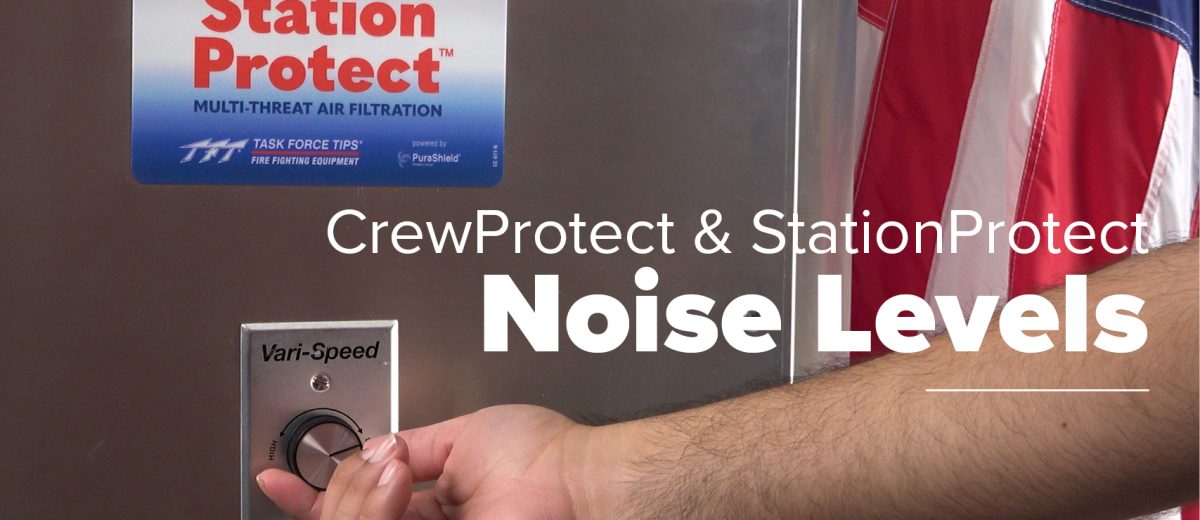How Loud are the TFT Health Air Decon Units?
As you look for an apparatus cab and fire station air decontamination solution, you want something that won’t create a lot of extra noise for you to worry about. The last thing you need is to make your space even louder than it already can be or risk suffering hearing damage from a loud addition.
When we created the CrewProtect 100, CrewProtect 50, CrewProtect 20, and StationProtect, we wanted to create a product that wouldn’t be a nuisance to you and your crew. We made something simple to use, simple to maintain, and we made it quiet.
The suite of TFT air decontamination products registers well below NFPA (National Fire Protection Association) recommendations. Let’s look at how loud they are and compare those noise levels to other sounds you may be familiar with.
How Loud is Too Loud?
The NFPA makes recommendations for noise levels inside your firefighting vehicles. Their recommendation is to remain at 80 decibels or below. Using 80 decibels as a benchmark, your noise level maximum inside of an apparatus cab is similar to the noise level of a ringing doorbell or whistling kettle. When designing CrewProtect and CrewProtect 20, these recommendations were our guidelines.
The NFPA does not make noise level recommendations for the inside of your fire station. While designing StationProtect, our goal was to keep it quiet enough to use in living areas and sleeping quarters without disturbing the people nearby.
CrewProtect 20 Noise Level
The CrewProtect 20 runs at about 42 decibels in your firefighting vehicle. Because it operates quietly, the unit will not impede conversation or be a distraction in your smaller spaces. For comparison, the CrewProtect 20 is quieter than your average electric toothbrush. An electric toothbrush is typically around 50-60 decibels.
CrewProtect 50 Noise Level
The CrewProtect 50 runs at about 45 decibels in your firefighting vehicle. Because it operates quietly, the unit will not impede conversation or be a distraction in your smaller spaces. For comparison, the CrewProtect 50 is quieter than your average electric toothbrush. An electric toothbrush is typically around 50-60 decibels.
CrewProtect 100 Noise Level
The CrewProtect 100 operates at 60 decibels and is meant for your larger fire apparatus. This unit is quiet enough to run as background noise and won’t disturb your conversations. Normal conversation registers between 60 and 70 decibels, while a typical business office registers between 60 and 65 decibels.
StationProtect Noise Level
The NFPA does not currently have a recommendation for fire station noise levels. Knowing that you might use the unit in a living area or sleeping area and that fire stations can be noisy anyway, we kept the StationProtect very quiet. At max speed, the StationProtect is about 64 decibels, comparable to normal conversation levels. Since the unit has a speed control knob, you can also lower the speed and therefore lower the sound level. Its lowest speed operates at about 30 decibels, which is similar to a quiet rural area and slightly louder than a whisper. However, keep in mind as you lower the speed of the fans you are also decreasing the turnover rate of the air within your station.
How do these Noise Levels Compare with Other Air Decontamination Systems?
The CrewProtect 100 and StationProtect systems come in a little louder than the advertised noise levels of their competing products that use needlepoint bipolar ionization (NPBI™) technology. One prominent manufacturer advertises their station and apparatus units as running at 45 decibels, which is the same as the CrewProtect 20.
These units are quieter due to differences in the technology used. CrewProtect and StationProtect use a fan to push or pull air into the system and move it through the cartridge. This resistance adds some noise while giving you cleaner, safer air thanks to the multiple stages that capture particulate matter, VOCs, soot, and aerosols carrying viruses and bacteria. The sound of the fan moving air is white noise that offers very little disruption for most people.
In comparison, the NPBI units use fans to move air in a more open space. As this happens, an electrical charge creates positive and negative ions, and the airflow pushes them out into the cab or room. These ions travel through the air where they find and bind particles together. Because there is no filter, there is little resistance to the air. This leads to less noise. However, no filter means there is no particulate capture, and any combined particles will remain airborne until they fall from the breathing zone or get captured by another filter. The unit also makes a different type of sound. Where CrewProtect and StationProtect create a white noise, NPBI has a fan noise and a noise related to the electrical charge the unit creates. This type of noise may be more disruptive to some.
Conclusion
The CrewProtect 20, CrewProtect 50, CrewProtect 100, and StationProtect units are made with you in mind. Each one is designed to run quietly in the background below NFPA noise level recommendations. With any of these units, you will easily be able to hear your crew!
